10.3 Various Forms of the Equation of a Line
Lines Parallel to Coordinate Axes
Case-I: Equation of a line parallel to Y-axis
If a horizontal line \(\mathrm{L}\) is at a distance \(a\) from the \(x\)-axis then ordinate of every point lying on the line is either \(a\) or \(-a\) [Fig 10.11 (a)]. Therefore, equation of the line \(\mathrm{L}\) is either \(y=a\) or \(y=-a\). Choice of sign will depend upon the position of the line according as the line is above or below the y-axis.
Case-II: Equation of a line parallel to X-axis
Similarly, the equation of a vertical line at a distance \(b\) from the \(y\)-axis is either \(x=b\) or \(x=-b\) [Fig 10.11(b)].
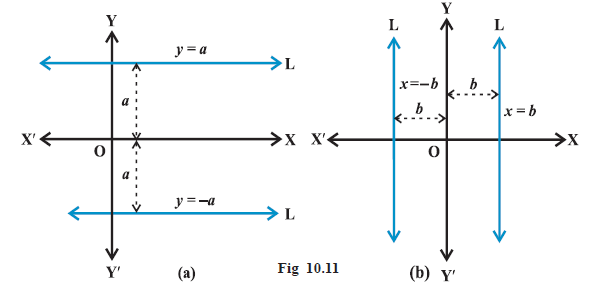
Example 1: Find the equations of the lines parallel to axes and passing through \((-2,3)\)
Answer: Position of the lines is shown in the Fig 10.12 . The \(y\)-coordinate of every point on the line parallel to \(x\)-axis is 3 , therefore, equation of the line parallel tox-axis and passing through \((-2,3)\) is \(y=3\). Similarly, equation of the line parallel to \(y\)-axis and passing through \((-2,3)\) is \(x=-2\).
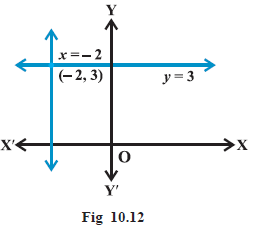
Example 2: Find the equation of a line which is equidistant from the lines \(x=-\frac{7}{2}\) and \(x=\frac{15}{2}\).
Answer: Since, the given (both) lines are parallel to \(Y\)-axis and the required line is equidistant from these lines, so it is also parallel to \(Y\)-axis. Let equation of any line parallel to \(Y\)-axis is \(x=a\)
Here, \(a=\frac{\left(-\frac{7}{2}+\frac{15}{2}\right)}{2}=\frac{8}{4}=2\) units
Hence, its equation is \(x=2\).
Different Forms of the Equation of a Straight Line
Case-I: Point-slope form
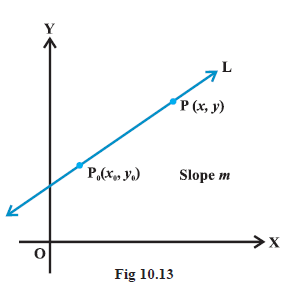
Point-slope form Suppose that \(\mathrm{P}_0\left(x_{0^{\prime}} y_0\right)\) is a fixed point on a non-vertical line \(\mathrm{L}\), whose slope is \(m\). Let \(\mathrm{P}(x, y)\) be an arbitrary point on \(\mathrm{L}\) (Fig 10.13).
Then, by the definition, the slope of \(L\) is given by
\(
m=\frac{y-y_0}{x-x_0} \text {, i.e., } y-y_0=m\left(x-x_0\right) \dots(1)
\)
Since the point \(\mathrm{P}_0\left(x_0, y_0\right)\) along with all points \((x, y)\) on \(\mathrm{L}\) satisfies (1) and no other point in the plane satisfies (1). Equation (1) is indeed the equation for the given line L.
Thus, the point \((x, y)\) lies on the line with slope \(m\) through the fixed point \(\left(x_0, y_0\right)\), if and only if, its coordinates satisfy the equation
\(
y-y_0=m\left(x-x_0\right)
\)
This equation is called point-slope form or one point form of the equation.
Example 3: Find the equation of the line through \((-2,3)\) with slope -4.
Answer: Here \(m=-4\) and given point \(\left(x_0, y_0\right)\) is \((-2,3)\).
By slope-intercept form formula (1) above, equation of the given line is \(y-3=-4(x+2)\) or \(4 x+y+5=0\), which is the required equation.
Example 4: Find the equation of the straight line bisecting the segment joining the points \((5,3)\) and \((4,4)\) and making an angle of \(45^{\circ}\) with the positive direction of \(X\)-axis.
Answer: Here, \(m=\) slope of the line \(=\tan 45^{\circ}=1\).
Let \(A\) be the mid-point of \((5,3)\) and \((4,4)\). Then, the coordinates of \(A\) are
\(
\left(\frac{5+4}{2}, \frac{3+4}{2}\right) \text { i.e. }\left(\frac{9}{2}, \frac{7}{2}\right)
\)
Hence, the required equation of the line is
\(
y-\frac{7}{2}=1\left(x-\frac{9}{2}\right)
\)
\(
x-y-1=0
\)
Example 5: Find the equation of the right bisector of the line joining \((1,1)\) and \((3,5)\).
Answer: Let \(m\) be the slope of the line joining \((1,1)\) and \((3,5)\).
Then, \(\quad m=\frac{5-1}{3-1}=\frac{4}{2}=2\)
\(\therefore\) Slope \((M)\) of right bisector of the join of \((1,1)\)
and \(\quad(3,5)=-\frac{1}{m}\)
\(\therefore \quad M=-\frac{1}{2}\)
Mid-point of the join of \((1,1)\) and \((3,5)\) is \(\left(\frac{1+3}{2}, \frac{1+5}{2}\right)\) i.e. \((2,3)\).
Hence, equation of the right bisector passing through \((2,3)\) and having slope \(\quad M=-\frac{1}{2}\) is
\(
y-3=-\frac{1}{2}(x-2)
\)
\(
x+2 y-8=0
\)
Case-II: Two-point form of a line
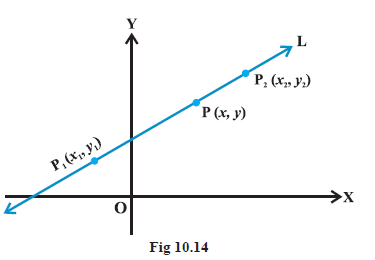
Two-point form Let the line \(\mathrm{L}\) passes through two given points \(\mathrm{P}_1\left(x_1, y_1\right)\) and \(\mathrm{P}_2\left(x_2, y_2\right)\). Let \(\mathrm{P}(x, y)\) be a general point on L (Fig 10.14).
The three points \(\mathrm{P}_1, \mathrm{P}_2\) and \(\mathrm{P}\) are collinear, therefore, we have slope of \(\mathrm{P}_1 \mathrm{P}=\) slope of \(\mathrm{P}_1 \mathrm{P}_2\)
\(
\text { i.e., } \quad \frac{y-y_1}{x-x_1}=\frac{y_2-y_1}{x_2-x_1}, \quad \text { or } \quad y-y_1=\frac{y_2-y_1}{x_2-x_1}\left(x-x_1\right) \text {. }
\)
Thus, equation of the line passing through the points \(\left(x_1, y_1\right)\) and \(\left(x_2, y_2\right)\) is given by
\(
y-y_1=\frac{y_2-y_1}{x_2-x_1}\left(x-x_1\right) \dots(2)
\)
Example 6: Write the equation of the line through the points \((1,-1)\) and \((3,5)\).
Answer: Here \(x_1=1, y_1=-1, x_2=3\) and \(y_2=5\). Using two-point form (2) above for the equation of the line, we have
\(
y-(-1)=\frac{5-(-1)}{3-1}(x-1)
\)
\(-3 x+y+4=0\), which is the required equation.
Example 7: Let \(A B C\) be a triangle with \(A(-1,-5)\), \(B(0,0)\) and \(C(2,2)\) and let \(D\) be the middle point of \(B C\). Find the equation of the perpendicular drawn from \(B\) to \(A D\).
Answer:
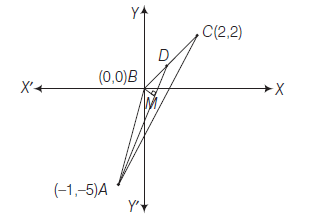
\(\because D\) is the middle point of \(B C\).
\(\therefore\) Coordinates of \(D\) are \(\left(\frac{0+2}{2}, \frac{0+2}{2}\right)\)
\(
\text { i.e. } D(1,1)
\)
Slope of median \(A D=\frac{1+5}{1+1}=3\)
\(\therefore \quad\) Slope of \(B M\) which is perpendicular to \(A D=-\frac{1}{3}\). Hence, equation of the line \(B M\) is
\(
y-0=-\frac{1}{3}(x-0) \Rightarrow x+3 y=0
\)
which is the required equation of the line.
Example 8: The vertices of a triangle are \(A(10,4), B(-4,9)\) and \(C(-2,-1)\). Find the equation of the altitude through \(A\).
Answer: \(\because\) Slope of \(B C=\frac{-1-9}{-2+4}=\frac{-10}{2}=-5\)
\(\therefore\) Slope of altitude \(A D=-\frac{1}{-5}=\frac{1}{5}\)
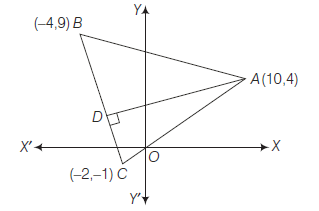
Hence, equation of altitude \(A D\) which passes through \((0,4)\) and having slope \(\frac{1}{5}\) is
\(
y-4=\frac{1}{5}(x-10)
\)
\(
x-5 y+10=0
\)
Example 9: Find the equations of the medians of a triangle, the coordinates of whose vertices are \((-1,6),(-3,-9)\) and \((5,-8)\).
Answer: Let \(A(-1,6), B(-3,-9)\) and \(C(5,-8)\) be the vertices of \(\triangle A B C\). Let \(D, E\) and \(F\) be the mid-points of the sides \(B C, C A\) and \(A B\) respectively.
Coordinates of \(D \equiv\left(\frac{-3+5}{2}, \frac{-9-8}{2}\right)\)
i.e. \(\left(1,-\frac{17}{2}\right)\)
Coordinates of \(E \equiv\left(\frac{5-1}{2}, \frac{-8+6}{2}\right)\)
i.e. \((2,-1)\)
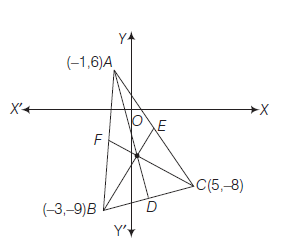
and coordinates of \(F \equiv\left(\frac{-1-3}{2}, \frac{6-9}{2}\right)\)
i.e. \((-2,-3 / 2)\)
\(\therefore\) Equation of the median \(A D=\) Equation of line through \((-1,6)\) and \(\left(1,-\frac{17}{2}\right)\) is
\(
\begin{aligned}
y-6 & =\frac{-\frac{17}{2}-6}{1+1}(x+1) \\
\Rightarrow \quad y-6 & =-\frac{29}{4}(x+1) \text { or } 29 x+4 y+5=0
\end{aligned}
\)
Equation of median \(B E\) is
\(
y+9=\frac{-1+9}{2+3}(x+3) \text { or } 8 x-5 y-21=0
\)
and equation of median \(C F\) is
\(
y+8=\frac{-\frac{3}{2}+8}{-2-5}(x-5)
\)
or \(\quad 13 x+14 y+47=0\)
Example 10: Find the ratio in which the line segment joining the points \((2,3)\) and \((4,5)\) is divided by the line joining \((6,8)\) and \((-3,-2)\).
Answer: The equation of line passing through \((6,8)\) and \((-3,-2)\) is
\(
\begin{array}{ll}
& y-8=\frac{-2-8}{-3-6}(x-6) \\
\Rightarrow & 9 y-72=10 x-60 \\
\text { or } & 10 x-9 y+12=0 \dots(i)
\end{array}
\)
Let the required ratio be \(\lambda: 1\).
Now, the coordinates of the point \(P\) which divide the line segment joining the points \((2,3)\) and \((4,5)\) in the ratio \(\lambda: 1\) is
\(
P\left(\frac{2+4 \lambda}{1+\lambda}, \frac{3+5 \lambda}{1+\lambda}\right)
\)
Clearly \(P\) lies on Eq. (i), then
\(
10\left(\frac{2+4 \lambda}{1+\lambda}\right)-9\left(\frac{3+5 \lambda}{1+\lambda}\right)+12=0
\)
\(
20+40 \lambda-27-45 \lambda+12+12 \lambda=0
\)
\(
7 \lambda+5=0 \text { or } \lambda=-\frac{5}{7}
\)
\(\therefore\) The required ratio \(=\lambda: 1=-\frac{5}{7}: 1=-5: 7\)
Hence, the required ratio is \(5: 7\) (externally).
Case-III: Slope-intercept form
Slope-intercept form Sometimes a line is known to us with its slope and an intercept on one of the axes. We will now find equations of such lines.
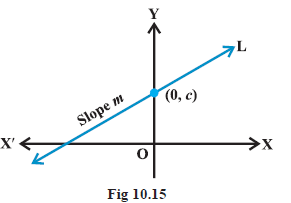
Case 1: Suppose a line \(\mathrm{L}\) with slope \(m\) cuts the \(y\)-axis at a distance \(c\) from the origin (Fig10.15). The distance \(c\) is called the \(y\) intercept of the line L. Obviously, coordinates of the point where the line meet the \(y\)-axis are \((0, c)\). Thus, \(L\) has slope \(m\) and passes through a fixed point \((0, c)\). Therefore, by point-slope form, the equation of \(L\) is
\(
y-c=m(x-0) \text { or } y=m x+c
\)
Thus, the point \((x, y)\) on the line with slope \(m\) and \(y\)-intercept \(c\) lies on the line if and only if
\(
y=m x+c \dots(3)
\)
Note that the value of \(c\) will be positive or negative according as the intercept is made on the positive or negative side of the \(y\)-axis, respectively.
Case 2: Suppose line \(\mathrm{L}\) with slope \(m\) makes \(x\)-intercept \(d\). Then equation of \(\mathrm{L}\) is
\(
y=m(x-d) \dots(4)
\)
Example 11: Write the equation of the lines for which \(\tan \theta=\frac{1}{2}\), where \(\theta\) is the inclination of the line and (i) \(y\)-intercept is \(-\frac{3}{2}\) (ii) \(x\)-intercept is 4.
Answer: (i) Here, slope of the line is \(m=\tan \theta=\frac{1}{2}\) and \(y\)-intercept \(c=-\frac{3}{2}\).
Therefore, by slope-intercept form (3) above, the equation of the line is
\(
y=\frac{1}{2} x-\frac{3}{2} \text { or } 2 y-x+3=0,
\)
which is the required equation.
(ii) Here, we have \(m=\tan \theta=\frac{1}{2}\) and \(d=4\).
Therefore, by slope-intercept form (4) above, the equation of the line is
\(
y=\frac{1}{2}(x-4) \text { or } 2 y-x+4=0,
\)
which is the required equation.
Example 12: Find the equation of the straight line cutting off an intercept of 3 units on negative direction of \(Y\)-axis and inclined at an angle \(\tan ^{-1}\left(\frac{3}{5}\right)\) to the axis of \(x\).
Answer: Here, \(\quad c=-3\) and \(\theta=\tan ^{-1}\left(\frac{3}{5}\right)\) or \(\tan \theta=\frac{3}{5}=m\)
Hence, the equation of the line i.e.
\(
\begin{array}{c}
y=m x+c \\
y=\frac{3}{5} x-3
\end{array}
\)
\(
3 x-5 y-15=0
\)
Example 13: Find the equation to the straight line cutting off an intercept of 5 units on negative direction of \(Y\)-axis and being equally inclined to the axes.
Answer: Here,
\(
\begin{array}{l}
c=-5 \\
m=\tan 45^{\circ} \text { or } \tan 135^{\circ}
\end{array}
\)
i.e. \(\quad m= \pm 1\)
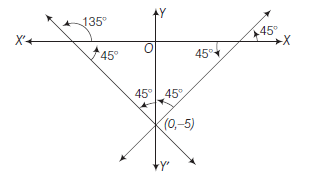
Hence, required equation is
\(
\begin{aligned}
y & =( \pm 1) x-5 \\
\text { or } \quad y & = \pm x-5
\end{aligned}
\)
Example 14: Find the equations of the bisectors of the angle between the coordinate axes.
Answer: Let \(L_1\) and \(L_2\) be the straight lines bisecting the co-ordinate axes.
Both \(L_1\) and \(L_2\) pass through origin
\(\therefore\) Equation of line through origin is \(y=m x\) for \(L_1, m=\tan 45^{\circ}=1\)
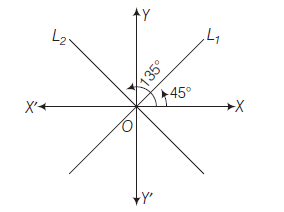
\(\therefore\) Equation of line \(L_1\) is \(y=x\)
i.e.
\(
x-y=0
\)
For \(L_2, m=\tan 135^{\circ}=-1\)
\(\therefore\) Equation of line \(L_2\) is \(y=-x\)
i.e.
\(
x+y=0
\)
Hence, equations of the bisectors of the angle between the coordinate axes are \(x \pm y=0\).
Case-IV: The Intercept Form of a Line
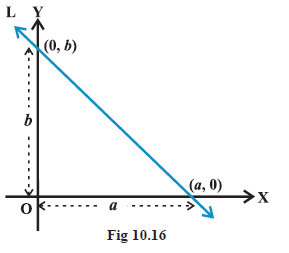
Suppose a line L makes \(x\)-intercept \(a\) and \(y\)-intercept \(b\) on the axes. Obviously \(\mathrm{L}\) meets \(x\)-axis at the point \((a, 0)\) and \(y\)-axis at the point \((0, b)\) (Fig .10.16). By two-point form of the equation of the line, we have
\(
y-0=\frac{b-0}{0-a}(x-a) \text { or } a y=-b x+a b \text {, }
\)
i.e.,
\(
\frac{x}{a}+\frac{y}{b}=1 \text {. }
\)
Thus, equation of the line making intercepts \(a\) and \(b\) on \(x\)-and \(y\)-axis, respectively, is
\(
\frac{x}{a}+\frac{y}{b}=1 \dots(5)
\)
Example 15: Find the equation of the line, which makes intercepts -3 and 2 on the \(x\) – and \(y\)-axes respectively.
Answer: Here \(a=-3\) and \(b=2\). By intercept form (5) above, equation of the line is
\(
\frac{x}{-3}+\frac{y}{2}=1 \text { or } 2 x-3 y+6=0 \text {. }
\)
Example 16: Find the equation of the line through \((2,3)\) so that the segment of the line intercepted between the axes is bisected at this point.
Answer:
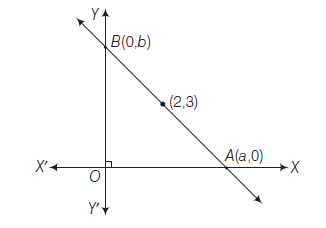
Let the required line segment be \(A B\).
Let \(O\) be the origin and \(O A=a\) and \(O B=b\).
Then the coordinates of \(A\) and \(B\) are \((a, 0)\) and \((0, b)\) respectively.
\(
\begin{array}{lll}
\therefore & & \frac{a+0}{2}=2 \Rightarrow a=4 \\
\text { and } & \frac{0+b}{2} & =3 \Rightarrow b=6
\end{array}
\)
Hence, the equation of the required line is
\(
\begin{array}{ll}
& \frac{x}{4}+\frac{y}{6}=1 \\
\text { i.e. } \quad 3 x+2 y & =12
\end{array}
\)
Example 17: Find the equation to the straight line which passes through the points \((3,4)\) and have intercepts on the axes:
(a) equal in magnitude but opposite in sign
(b) such that their sum is 14
Answer: (a) Let intercepts on the axes be \(a\) and \(-a\) respectively.
\(\therefore\) The equation of the line in intercept form is
\(
\frac{x}{a}+\frac{y}{-a}=1 \text { or } x-y=a \dots(i)
\)
Since, Eq. (i) passes through \((3,4)\), then
\(
\begin{aligned}
& & 3-4 & =a \\
& \therefore & a & =-1
\end{aligned}
\)
From Eq. (i), \(x-y+1=0\)
which is the required equation of the line.
(b) Let the equation of the line be \(\frac{x}{a}+\frac{y}{b}=1\)
This passes through \((3,4)\).
Therefore \(\frac{3}{a}+\frac{4}{b}=1 \dots(ii)\)
It is given that \(a+b=14\)
\(
\therefore \quad b=14-a
\)
Putting \(b=14-a\) in Eq. (ii), we get
\(
\begin{aligned}
\frac{3}{a}+\frac{4}{14-a} & =1 \\
42-3 a+4 a & =14 a-a^2 \\
a^2-13 a+42 & =0 \\
(a-7)(a-6) & =0 \\
a & =6,7
\end{aligned}
\)
Then,
\(
b=8,7 \quad(\because b=14-a)
\)
Hence, the required equations are
\(
\frac{x}{6}+\frac{y}{8}=1 \text { and } \frac{x}{7}+\frac{y}{7}=1
\)
i.e.
\(
4 x+3 y=24 \text { and } x+y=7
\)
Example 18: Find the equation of the straight line through the point \(P(a, b)\) parallel to the line \(\frac{x}{a}+\frac{y}{b}=1\). Also find the intercepts made by it on the axes.
Answer: Let the line \(\frac{x}{a}+\frac{y}{b}=1\) meets the axes in \(A\) and \(B\) respectively. So that
\(
O A=a, O B=b
\)
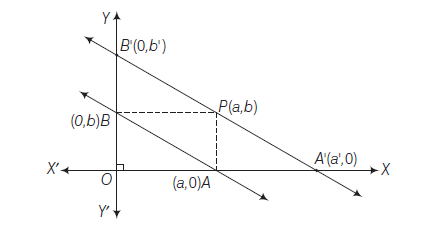
Let the required parallel line meet in \(A^{\prime}\) and \(B^{\prime}\) respectively, so that
\(
\begin{array}{lll}
O A^{\prime}=a^{\prime} \text { (say) }\\
\text { and } O B^{\prime}=b^{\prime} \text { (say) }
\end{array}
\)
\(\therefore\) Equation of required line is
\(
\frac{x}{a^{\prime}}+\frac{y}{b^{\prime}}=1 \dots(i)
\)
Since, \(\Delta^{\prime} s O A B\) and \(O A^{\prime} B^{\prime}\) are similar, then
\(
\begin{aligned}
& \frac{O A^{\prime}}{O A} =\frac{O B^{\prime}}{O B} \\
\text { i.e. } & \frac{a^{\prime}}{a} =\frac{b^{\prime}}{b}=\lambda \text { (say) }\\
\Rightarrow & a^{\prime} =a \lambda, b^{\prime}=b \lambda
\end{aligned}
\)
Substituting these values in Eq. (i), then
\(
\frac{x}{a \lambda}+\frac{y}{b \lambda}=1 \dots(ii)
\)
It passes through \((a, b)\), then
\(
\begin{aligned}
& \frac{a}{a \lambda}+\frac{b}{b \lambda}=1 \\
\Rightarrow \quad & \frac{2}{\lambda}=1 \text { or } \lambda=2
\end{aligned}
\)
From Eq. (ii) required equation is
\(
\frac{x}{2 a}+\frac{y}{2 b}=1
\)
Evidently intercepts on the axes are \(2 a\) and \(2 b\).
Case-V: The Normal Form or Perpendicular Form of a Line
Suppose a non-vertical line is known to us with following data:
(i) Length of the perpendicular (normal) from origin to the line.
(ii) Angle which normal makes with the positive direction of \(x\)-axis.
Let \(\mathrm{L}\) be the line, whose perpendicular distance from origin \(\mathrm{O}\) be \(\mathrm{OA}=p\) and the angle between the positive \(x\)-axis and \(\mathrm{OA}\) be \(\angle \mathrm{XOA}=\omega\). The possible positions of line \(\mathrm{L}\) in the Cartesian plane are shown in the Fig 10.17. Now, our purpose is to find slope of \(\mathrm{L}\) and a point on it. Draw perpendicular AM on the \(x\)-axis in each case.
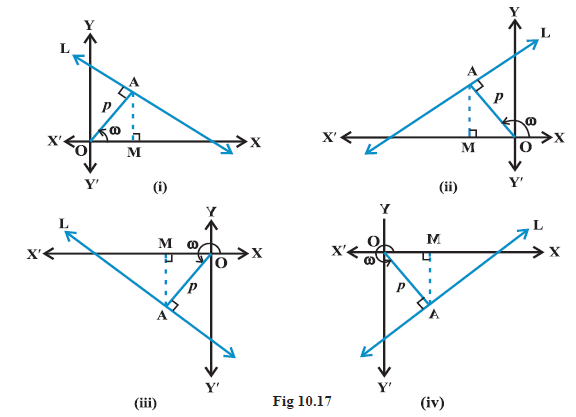
In each case, we have \(\mathrm{OM}=p \cos \omega\) and \(\mathrm{MA}=p \sin \omega\), so that the coordinates of the point \(\mathrm{A}\) are \((p \cos \omega, p \sin \omega)\).
Further, line \(\mathrm{L}\) is perpendicular to OA. Therefore
The slope of the line \(L=-\frac{1}{\text { slope of OA }}=-\frac{1}{\tan \omega}=-\frac{\cos \omega}{\sin \omega}\).
Thus, the line \(\mathrm{L}\) has slope \(-\frac{\cos \omega}{\sin \omega}\) and point \(\mathrm{A}(p \cos \omega, p \sin \omega)\) on it. Therefore, by point-slope form, the equation of the line \(\mathrm{L}\) is
\(
y-p \sin \omega=-\frac{\cos \omega}{\sin \omega}(x-p \cos \omega) \text { or } x \cos \omega+y \sin \omega=p\left(\sin ^2 \omega+\cos ^2 \omega\right)
\)
or \(\quad x \cos \omega+y \sin \omega=p\).
Hence, the equation of the line having normal distance \(p\) from the origin and angle \(\omega\) which the normal makes with the positive direction of \(x\)-axis is given by
\(
x \cos \omega+y \sin \omega=p \dots(6)
\)
Example 19: Find the equation of the line whose perpendicular distance from the origin is 4 units and the angle which the normal makes with positive direction of \(x\)-axis is \(15^{\circ}\).
Answer:
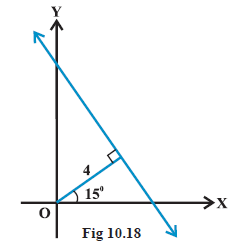
Here, we are given \(p=4\) and \(\omega=15^{\circ}\) (Fig10.18).
Now
\(
\cos 15^{\circ}=\frac{\sqrt{3}+1}{2 \sqrt{2}}
\)
and \(\quad \sin 15^{\circ}=\frac{\sqrt{3}-1}{2 \sqrt{2}}\)
By the normal form (6) above, the equation of the line is
\(
x \cos 15^{\circ}+y \sin 15^{\circ}=4 \text { or } \frac{\sqrt{3}+1}{2 \sqrt{2}} x+\frac{\sqrt{3}-1}{2 \sqrt{2}} y=4 \text { or }(\sqrt{3}+1) x+(\sqrt{3}-1) y=8 \sqrt{2} \text {. }
\)
This is the required equation.
Example 20: The Fahrenheit temperature \(\mathrm{F}\) and absolute temperature \(\mathrm{K}\) satisfy a linear equation. Given that \(\mathrm{K}=273\) when \(\mathrm{F}=32\) and that \(\mathrm{K}=373\) when \(\mathrm{F}=212\). Express \(\mathrm{K}\) in terms of \(\mathrm{F}\) and find the value of \(\mathrm{F}\), when \(\mathrm{K}=0\).
Answer: Assuming \(\mathrm{F}\) along \(x\)-axis and \(\mathrm{K}\) along \(y\)-axis, we have two points \((32,273)\) and \((212,373)\) in XY-plane. By two-point form, the point \((F, K)\) satisfies the equation
\(
\begin{array}{l}
\mathrm{K}-273=\frac{373-273}{212-32}(\mathrm{~F}-32) \text { or } \mathrm{K}-273=\frac{100}{180}(\mathrm{~F}-32) \\
\text { or } \quad \mathrm{K}=\frac{5}{9}(\mathrm{~F}-32)+273
\end{array}
\)
which is the required relation.
When \(K=0\), Equation (1) gives
\(
0=\frac{5}{9}(F-32)+273 \text { or } F-32=-\frac{273 \times 9}{5}=-491.4 \text { or } F=-459.4
\)
Alternate method
We know that simplest form of the equation of a line is \(y=m x+c\). Again assuming \(\mathrm{F}\) along \(x\)-axis and \(\mathrm{K}\) along \(y\)-axis, we can take equation in the form
\(
\mathrm{K}=m \mathrm{~F}+c \dots(1)
\)
Equation (1) is satisfied by \((32,273)\) and \((212,373)\). Therefore
\(
273=32 m+c \dots(2)
\)
and
\(
373=212 m+c \dots(3)
\)
Solving (2) and (3), we get
\(
m=\frac{5}{9} \text { and } c=\frac{2297}{9} \text {. }
\)
Putting the values of \(m\) and \(c\) in (1), we get
\(
\mathrm{K}=\frac{5}{9} \mathrm{~F}+\frac{2297}{9} \dots(4)
\)
which is the required relation. When \(\mathrm{K}=0\), (4) gives \(\mathrm{F}=-459.4\).
Example 21: The length of perpendicular from the origin to a line is 9 and the line makes an angle of \(120^{\circ}\) with the positive direction of \(Y\)-axis. Find the equation of the line.
Answer: Here, \(\alpha=60^{\circ}\) and \(p=9\).
\(\therefore\) Equation of the required line is
\(
x \cos 60^{\circ}+y \sin 60^{\circ}=9
\)

\begin{array}{rlrl}
\Rightarrow & x\left(\frac{1}{2}\right)+y\left(\frac{\sqrt{3}}{2}\right) =9 \\
& \text { or } & x+y \sqrt{3} =18
\end{array}
\)
Example 22: Find the equation of the straight line on which the perpendicular from origin makes an angle of \(30^{\circ}\) with \(X\)-axis and which forms a triangle of area \(\left(\frac{50}{\sqrt{3}}\right)\) sq units with the coordinates axes.
Answer: Let \(\angle N O A=30^{\circ}\)
Let \(O N=p>0, O A=a, O B=b\)
\(
\text { In } \triangle O N A, \quad \cos 30^{\circ}=\frac{O N}{O A}=\frac{p}{a}
\)
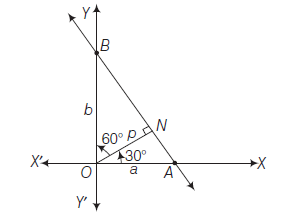
\(
\frac{\sqrt{3}}{2}=\frac{p}{a} \quad \text { or } a=\frac{2 p}{\sqrt{3}}
\)
\(
\begin{array}{l}
\text { and in } \triangle O N B, \cos 60^{\circ}=\frac{O N}{O B}=\frac{p}{b} \\
\Rightarrow \quad \frac{1}{2}=\frac{p}{b} \text { or } b=2 p \\
\because \quad \text { Area of } \triangle O A B=\frac{1}{2} a b=\frac{1}{2}\left(\frac{2 p}{\sqrt{3}}\right) \\
\end{array}
\)
\(
\begin{array}{l}
(2 p)=\frac{2 p^2}{\sqrt{3}} \\
\frac{2 p^2}{\sqrt{3}}=\frac{50}{\sqrt{3}} \text { (given) }
\end{array}
\)
\(
\begin{aligned}
p^2 & =25 \\
p & =5 \quad(\because p>0)
\end{aligned}
\)
\(\therefore\) Using \(x \cos \alpha+y \sin \alpha=p\), the equation of the line \(A B\) is
\(
\begin{array}{ll}
& x \cos 30^{\circ}+y \sin 30^{\circ}=5 \\
\text { or } \quad & x \sqrt{3}+y=10
\end{array}
\)